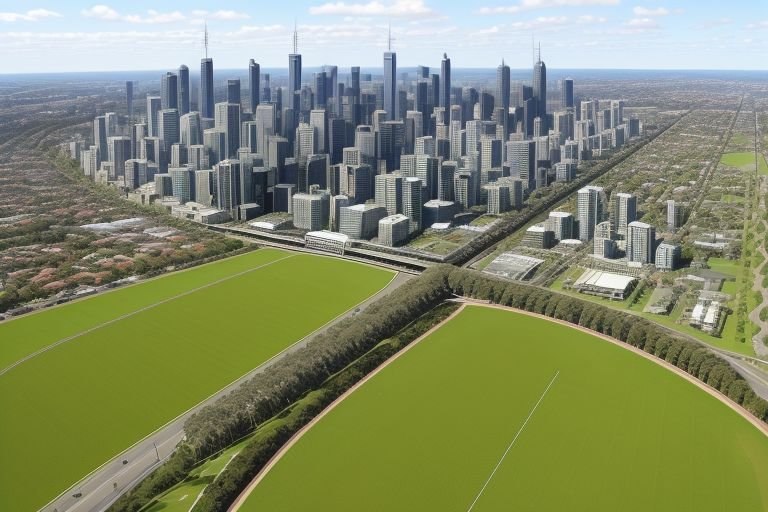Melbourne locals can expect to see sweeping changes to the urban built environment as planning for a new project to extend green corridors across the city is initiated. The initiative, dubbed “Melbourne Greenways,” was unveiled today by Lord Mayor Sally Capp in a press conference at Town Hall, marking a significant step towards enhancing the city’s sustainability and livability.
Melbourne Greenways plans to extend more than 100km of green streets, pedestrian realm and cycle tracks integrated into a network that passes through the city’s suburbs and neighbourhoods. This vast connectivity is expected to offer the citizen and tourists safer and ecofriendly means of transport and recreation in a bid to meet some of the stern environmental challenges like UHI islands and loss of habitat.
Pivoting on the concept of realizing such previously dormant and marginalized infrastructures, such as degraded rail lines, empty lots, or widened carriageways, there is the concept of green corridors. These corridors will include a combination of natural vegetation, community plantations and recreation areas and avenues, to provide a functional green matrix for both ecological and social needs.
Lord Mayor Capp said that Melbourne Greenways is our vision for creating a better city that is environmentally friendly, economically sustainable, and socially sustainable for the future. By reimagining our urban spaces, we’re not just improving our environment; we’re enhancing the quality of life for all Melburnians.”
It is a long-term development plan for the next decade or so, with the implementation planned in stages: the initial stage will involve linking existing facilities such as parks and gardens in the inner city. Further expansion will take the network into suburban regions, thus completing a coherent green network across the whole of the metropolitan area.
Another area of interest that is unique to the Melbourne Greenways project is the focus on sustainable transport. The new corridors will feature priority on pedestrians and cyclists, providing a safe and appealing connection that fosters activity travel. In addition to addressing this objective, this aspect of the project is well in line with the direction the city would like to take in terms of trying to wean itself out of the car and the carbon emissions that come with it.
The launch has attracted appreciation from environmental professionals because of the capacity of this move towards solving various urban issues at the same time. Dr. Emily Chen, an urban ecologist at the University of Melbourne, commented, “This project has the potential to improve Melbourne’s ecological health significantly. By creating corridors of native vegetation, we’re not only providing habitats for local flora and fauna but also establishing natural cooling systems that can help mitigate the urban heat island effect.”
Other appealing arguments are also being put to the fiscal impacts of the project. It is hope that the establishment and development of the greenways will generate thousand of employment opportunities in the specialty of landscaping, construction, urban planning and others. Furthermore, the improved property values along the green corridors are expected to increase and may encourage further economic growth in the neighboring regions.
I, however, see that the ambitiousness of the project has caused controversy regarding its viability and financial sustainability. The costs are expected to be about $2.5 billion; however, the controversy on the cost has most often been discussed and debated by councilors and city inhabitants in the region. To this end, the city has come up with a combination of funding strategies that involve the city’s budget, corporate partnerships, and community drives.
Some of the local business people have complained that their operations may be affected by the disruption caused by construction work. In response, the city leaders have assured that they would engage with the affected businesses mainly to ensure disruption is kept to a minimum while also understanding how the expectations of higher people traffic from those greenways will benefit those businesses.
In this respect, the organizational structure and dynamics of the project are going to be heavily reliant on the processes and mechanisms of community engagement. The city has stated that it will engage its citizens in consultations, setting up meetings through which people can avail comments on the design of greenways within their community. They want to get an overall view of what different communities of Melbourne would want in the project on their own so that the project cater adequately for them.
The Melbourne Greenways project also involves the proposals of hi-tech elements like urban forests, wetlands and wildlife corridors. All of these elements are supposed to create conditions which will improve the number of species and develop the possibilities for people to get more information about ecosystems.
Currently, awareness of the project has attracted the attention of urban planners and environmentalists from all parts of the globe. Melbourne’s policy is making waves as policymakers from around the world begin to take seriously the challenges posed by the twin phenomena of urbanization and climate change.
The objective of the project does not limit itself to construction and infrastructure creation. It is a process of wanting to change the perception of the people about their environment for the better. As the concept of Melbourne Greenways develops, new connections between the core of a city and natural areas are expected to be created with the aim of reducing the gap between people and nature and making people experience the importance of environmental protection.
Melbourne, therefore, has the world watching as it sets out to reinvent its cities’ physiques in the coming years totally. Suppose the Melbourne Greenways project is successful and that the new model of green infrastructure in the urban environment can be replicated in other cities all around the world. For now, Melburnians can look forward to a greener, more connected, and more sustainable future as their city takes a bold step towards becoming a true “city in a forest.”

